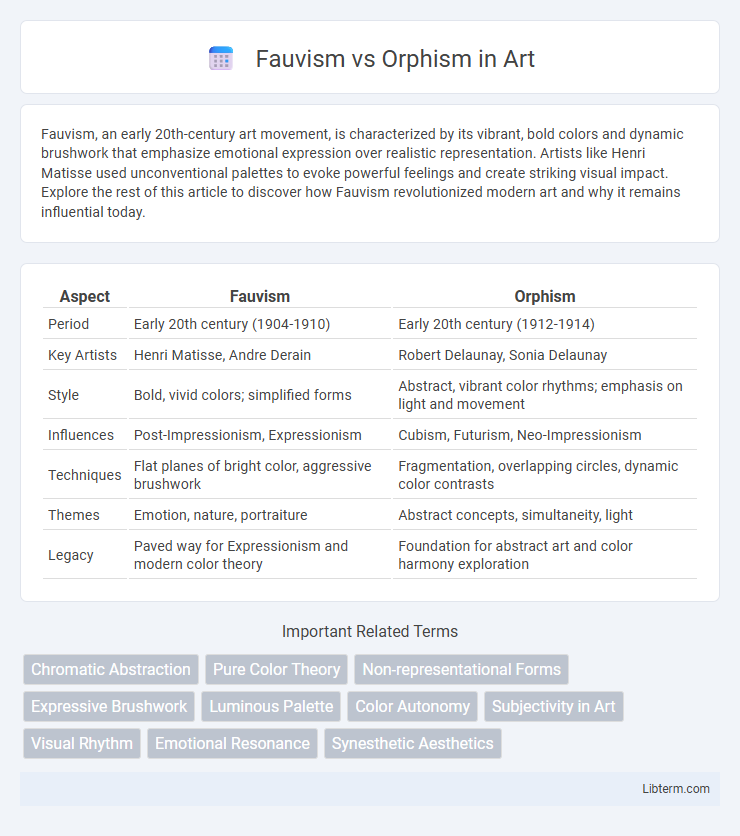Fauvism, an early 20th-century art movement, is characterized by its vibrant, bold colors and dynamic brushwork that emphasize emotional expression over realistic representation. Artists like Henri Matisse used unconventional palettes to evoke powerful feelings and create striking visual impact. Explore the rest of this article to discover how Fauvism revolutionized modern art and why it remains influential today.
Table of Comparison
| Aspect | Fauvism | Orphism |
|---|---|---|
| Period | Early 20th century (1904-1910) | Early 20th century (1912-1914) |
| Key Artists | Henri Matisse, Andre Derain | Robert Delaunay, Sonia Delaunay |
| Style | Bold, vivid colors; simplified forms | Abstract, vibrant color rhythms; emphasis on light and movement |
| Influences | Post-Impressionism, Expressionism | Cubism, Futurism, Neo-Impressionism |
| Techniques | Flat planes of bright color, aggressive brushwork | Fragmentation, overlapping circles, dynamic color contrasts |
| Themes | Emotion, nature, portraiture | Abstract concepts, simultaneity, light |
| Legacy | Paved way for Expressionism and modern color theory | Foundation for abstract art and color harmony exploration |
Introduction to Fauvism and Orphism
Fauvism, emerging in the early 20th century, is characterized by vivid, non-naturalistic colors and bold brushwork, pioneered by artists like Henri Matisse and Andre Derain. Orphism, founded by Robert Delaunay and Sonia Delaunay, evolved from Cubism and emphasized abstract, lyrical color harmonies and musical rhythms. Both movements revolutionized modern art through their radical use of color but differed in Fauvism's focus on expressive painterly qualities versus Orphism's exploration of color as an autonomous, dynamic force.
Origins and Historical Context
Fauvism emerged in early 20th-century France around 1904, led by artists like Henri Matisse, emphasizing vibrant color and painterly qualities to break from traditional representation. Orphism, founded by Robert Delaunay in 1912, evolved from Cubism, integrating abstract color harmonies inspired by music and spirituality. Both movements responded to rapid industrialization and shifting cultural landscapes in Europe, reflecting avant-garde efforts to explore new artistic expressions.
Key Artists and Influencers
Fauvism, led by key artists Henri Matisse and Andre Derain, emphasized bold, vibrant colors and painterly qualities that broke away from realistic representation. Orphism, pioneered by Robert Delaunay and Sonia Delaunay, extended Cubism's fragmented forms by focusing on luminous color and abstract compositions influenced by musical rhythms. Both movements significantly influenced modern art, with Fauvism impacting Expressionism and Orphism contributing to the development of abstract art and color theory.
Philosophical Foundations
Fauvism emphasizes vivid, non-naturalistic colors to evoke emotional responses, rooted in the philosophy of expressing subjective experience over realism. Orphism combines Cubist structure with the rhythms and color harmonies inspired by music, reflecting a metaphysical pursuit of capturing the spiritual essence of forms. Both movements prioritize abstraction, yet Fauvism centers on raw emotional intensity while Orphism seeks a synthesis of sensory perception and cosmic harmony.
Color Theory and Use
Fauvism emphasizes bold, non-naturalistic colors applied with strong brushstrokes to evoke emotional intensity, prioritizing pure color as an autonomous visual element. Orphism extends Fauvist use of color by integrating a more lyrical, abstract approach where vibrant hues create rhythmic harmony and evoke musicality through fragmented forms. Both movements revolutionized color theory by shifting focus from representational use to expressive and symbolic functions within modern art.
Techniques and Brushwork
Fauvism is characterized by bold, spontaneous brushwork with vivid, non-naturalistic colors applied in broad, flat areas to evoke emotional intensity. Orphism, on the other hand, emphasizes lyrical abstraction through precise, rhythmic brushstrokes and a harmonic use of color to create a sense of musicality and movement. Both movements employ vibrant palettes, but Fauvism's technique is more raw and expressive, while Orphism presents a refined, geometric approach to color and form.
Subject Matter and Themes
Fauvism emphasizes vivid, non-naturalistic colors and simplified forms to depict landscapes, portraits, and everyday scenes with emotional intensity. Orphism extends Cubism by incorporating abstract, lyrical compositions centered on light, color, and musical harmony, often avoiding representational subject matter. Fauvism focuses on bold expression of external reality, while Orphism prioritizes abstract color rhythms and spiritual themes.
Influence on Modern Art
Fauvism's bold use of vibrant colors and simplified forms revolutionized modern art by breaking traditional representational boundaries and inspiring Expressionism. Orphism introduced a lyrical abstraction, emphasizing color harmony and rhythmic composition, which significantly influenced Cubism and abstract art developments. Both movements propelled the shift from realism to abstraction, shaping 20th-century artistic innovation.
Critical Reception and Legacy
Fauvism, characterized by its bold, non-naturalistic colors and emotional intensity, initially faced mixed critical reception but soon influenced modern art through its simplification of forms and vivid palette. Orphism, emerging from Cubism and developed by artists like Robert Delaunay, received praise for its lyrical abstraction and vibrant color harmonies, contributing significantly to the evolution of abstract art. Both movements left enduring legacies by challenging traditional representations and advancing the use of color as a primary expressive element in 20th-century painting.
Fauvism vs Orphism: A Comparative Analysis
Fauvism emphasizes bold, non-naturalistic colors and spontaneous brushwork to evoke emotional intensity, pioneered by artists like Henri Matisse and Andre Derain. Orphism, founded by Frantisek Kupka and Robert Delaunay, integrates Fauvist color use with Cubist geometry, focusing on lyrical abstraction and the interplay of light and color to express musical rhythms. Both movements revolutionized early 20th-century art through vibrant color but diverged in Fauvism's raw expressiveness versus Orphism's structured, dynamic composition.
Fauvism Infographic

 libterm.com
libterm.com